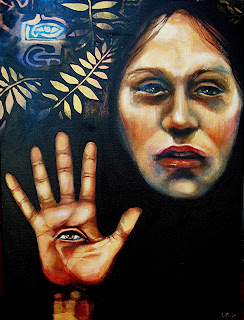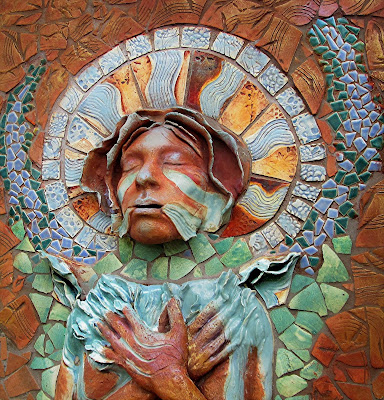Sunday, May 2, 2021
Friday, March 12, 2021
The Hand and the Eye
 "Hand and Eye" by Tylor Gore
"Hand and Eye" by Tylor Gore I've been fascinated for years with the hand and eye motif. A few years ago, while visiting a healer who does massage and energy work, I saw that she had an ancient native American artifact. It was of thick shell, about 3"x 2", stained, carved into the shape of a hand, incised to show the fingers and joints, and with an eye and pupil in the center of the palm. A hole was drilled in the top of this medallion or amulet, presumably so it could be worn with a cord.
I've been fascinated for years with the hand and eye motif. A few years ago, while visiting a healer who does massage and energy work, I saw that she had an ancient native American artifact. It was of thick shell, about 3"x 2", stained, carved into the shape of a hand, incised to show the fingers and joints, and with an eye and pupil in the center of the palm. A hole was drilled in the top of this medallion or amulet, presumably so it could be worn with a cord. Design engraved on Spiro shell; Hamilton, The Spiro Mound, Courtesy: Michael Fuller, Professor of Anthropology, St. Louis College (http://users.stlcc.edu/mfuller/spiroshell.html)
 For those unfamiliar with Serpent Mound, atop a plateau overlooking Brush Creek Valley, Serpent Mound is the largest landscape effigy in the United States. Nearly a quarter of a mile long, it apparently represents an uncoiling serpent; its "head" also represents an egg in the mouth of the serpent. It has been variously dated from about 1,400 years ago or older. It's also geomantically interesting that this ceremonial mound was built on the site of an ancient meteorite strike. Some scholars also believe it aligns with the summer solstices, and also, coincidentally, with the constellation "Draco", suggesting it was designed when the star draconis alpha was the pole star. Serpent Mound is certainly one of America's greatest archaeological mysteries. For a fascinating perspective on the spiritual and ritual uses of Serpent Mound, in particular upon the gestation cycles of women by independent artist and scholar Constance Tippett, visit her website The Moon at Serpent Mound (https://moonatserpentmound.org/about/)
For those unfamiliar with Serpent Mound, atop a plateau overlooking Brush Creek Valley, Serpent Mound is the largest landscape effigy in the United States. Nearly a quarter of a mile long, it apparently represents an uncoiling serpent; its "head" also represents an egg in the mouth of the serpent. It has been variously dated from about 1,400 years ago or older. It's also geomantically interesting that this ceremonial mound was built on the site of an ancient meteorite strike. Some scholars also believe it aligns with the summer solstices, and also, coincidentally, with the constellation "Draco", suggesting it was designed when the star draconis alpha was the pole star. Serpent Mound is certainly one of America's greatest archaeological mysteries. For a fascinating perspective on the spiritual and ritual uses of Serpent Mound, in particular upon the gestation cycles of women by independent artist and scholar Constance Tippett, visit her website The Moon at Serpent Mound (https://moonatserpentmound.org/about/) The artifact I held, a carved shell talismen of a Hand and Eye is probably 500 years of age, or older. Why did they wear it, why did they engrave it ?
The artifact I held, a carved shell talismen of a Hand and Eye is probably 500 years of age, or older. Why did they wear it, why did they engrave it ? |
| "Seeing in the Dark" (2009) |
 Here's an amazing "Hands with Eyes" mask made by artist Dan Lyke, which I found on the fabulous web page "Hand and Eye" created by T.P. Kunesh, whose fascinating (and wry) website shows him to be a philosopher and visionary worth knowing. My great thanks to Mr. Kunesh for the images and commentary he provided me with.
Here's an amazing "Hands with Eyes" mask made by artist Dan Lyke, which I found on the fabulous web page "Hand and Eye" created by T.P. Kunesh, whose fascinating (and wry) website shows him to be a philosopher and visionary worth knowing. My great thanks to Mr. Kunesh for the images and commentary he provided me with. "Hands Mask" by Dan Lyke at Burning Man (2000)
"Hands Mask" by Dan Lyke at Burning Man (2000)Here is some further information I have taken from the writings of Jungian psychologist Frank Adair, MD, and also from that of Joseph Campbell. Dr. Adair comments about this symbol:
"(The) inner Self has been likened to God or to "God within us". It has been called the light of nature that creates our dreams. Whatever "it" is called will involve some degree of projection limiting meaning. Somehow, the eye as symbol captures the pivotal point between the opposites, between the conscious and unconscious - where "the land meets the sea." The hand adds richness to the symbol. Hands can build the bridge between our inner world and the external world...The hands are the mediators between spirit and matter, between an inner image and an actual creation. By handling, the existing energies become visible."
Large ceremonial centers of the cultures collectively called the "Mound Builders" or the "Mississippian" cultures were found in Moundville, Alabama, Etowah in Georgia, Spiro in Oklahoma and Cahokia in Illinois, and elsewhere. It is suggested that the advent of Europeans coming to the so called New World (the old world to the nations already here) had much to do with the demise of these cultures through disease and conquest. The mounds are the greatest sources of the artifacts of these peoples. The eye, usually a simple oval containing a small circular pupil, may have represented the hand and eye of Creator. The famous disc below has a hand pointing upward, and appears to be both sides of the hand (perhaps suggesting non-duality?) There are two knotted rattlesnakes surrounding the hand. Being knotted, they could further suggest the forces symbolized by the snakes (the snake power contained, controlled, or organized by the hand? Earth Energies, symbolized so often by snakes or dragons in early European cultures? The protective power of the rattlesnake itself as it surrounds the sacred Hand?).
In ancient Europe and the Middle East "snake" was ubiquatous in its association with the Goddess, hence, the moving, serpentine, cyclical powers of the Earth/Earth Mother. While we cannot know what "snake" meant to these people, and the meanings of the iconic hand is only suggested by archaeologists, I think it can be said with some certainty that it did represent shamanistic power and/or deity. As Dr. Adair points out in his article, the motif of the "eye in the palm" is found in paintings of the compassionate Bodhisattva White Tara of Tibet, "She who hears the cries of the world". He further points out that none other than the great mythologist Joseph Campbell has mused and written possible meanings of this particular Native American stone disc:
"Interpreted in Oriental terms, its central sign would be said to represent the "fear banishing gesture" of a Bodhisattva hand showing on its palm the compassionate Eye of Mercy, pierced by the sight of the sorrows of this world. The framing pair of rattlesnakes, like those of the Aztec Calendar Stone, would then symbolize the maya power binding us to this vortex of rebirths, and the opposed knots would stand for the two doors, east and west, of the ascent and descent, appearances and disappearances, of all things in the endless round. Furthermore, the fact that the eye is at the center of the composition would suggest, according to this reading, that compassion is the ultimate sustaining and moving power of the universe, transcending and overcoming its pain. And finally, the fact that the hand is represented as though viewed simultaneously from back and front would say that this Bodhisattva power unites opposites.
Our picture depicts the dual aspects of psychic life which have been projected, since ancient times, as metaphysical realms. On the one hand, there is ordered consciousness symbolized by the regular appearance of the sun's "blazing eye;" on the other hand, there is the unconscious, a chaotic region of animal instincts, symbolized as "serpentine monsters" capable indeed of wrapping themselves around the ego and dragging it into its depths. Yet the American Indian projection preserves the fact that the unconscious is full of novelty and is a creative reality which can be harmonized with the structures of conscious living. That has been achieved aesthetically in our artifact.
The image of a "hand" at the center reminds us that this beautiful piece was made by human hands and hints at the requirement of human effort if we are ever to unite the opposites within ourselves. Should what we say here be more than intuition, should it also be rooted in the facts of the psyche and in the requirement to withdraw projections, then sensation has also been served. Serving opposite functions and honoring the larger duality of the conscious and unconscious psyche is, then, the modest modern equivalent of the prayers, offerings, and correct ethical behavior of the Mound Builders. (1)"
References:
Adair, Frank MD www.uroborus.com
Campbell, J. (1990). The Mythic Image. Princeton, NJ: Princeton University Press.
Fuller, Michael Ph.d.: Photos of artifacts from Spiro Mound courtesy Dr. Michael Fuller, Dept. of Anthropology, St. Louis Community College,(http://users.stlcc.edu/mfuller/spiroshell.html
Fundaburk, E.L. & Foreman, M.D. (1985). Sun Circles and Human Hands: The Southeastern Indians. Art and Industry. Fairhope, AL: American Bicentennial Museum.
Gore, Tyler, artist: http://www.tylergore.com/
Kunesh, T.P. The Eye in the Hand, http://www.darkfiber.com/eyeinhand/
Tippett, Constance (https://moonatserpentmound.org/about/
Walthall, J. (1994). Moundville: An introduction to the archaeology of a Mississippian chiefdom. Tuscaloosa, AL: Alabama Museum of Natural History.
Wednesday, September 12, 2018
Our Lady of the Desert Spring
.......Ann Waters, from "The Awakening: Our Changing Earth" (2013)
https://www.raicestaller222.com/
Monday, August 20, 2018
"Our Lady of the Shards" series..... New Work
 |
| The Memory Keeper |
 |
| The Weaver |
 |
| Our Lady of the Desert Spring |
 |
| Bone Woman |
 |
| Our Lady of the Midwives |
Wednesday, October 28, 2015
Friday, May 2, 2014
New Mosaic - "Our Lady of the Waters"
 |
| "Our Lady of the Waters" (2014) |
Lady of the Desert SpringNuestra Senora de las Aguas,
Our lady of the Arroyo,
Come quietly to us,
Come to us, and hear our prayers,
For those who suffer thirst,
Spread your mantle of green and turquoise
Among the red, parched lands
Bright artery of life
Nuestra Señora de las Aguas
Mother of the cottonwoods, the Palos verdes,
Snake and mallow, coyote and child
Hear our prayers
O desert spring,
Our lady of the waters.
Tile made from antique Afghani fabric press (2014) The Song of the Dry RiverDry. All you hearis the litany of traffic, a dusty haze obscuring the distance.Nothing sounds nowwhere once water sangamong the stones,voices of the livingwhere once a river rana river, once, herebefore cattle came,the carsthe minesliving as if the waterswould always flowto green the red and barren lands,as if the breast would never run dry.As if there none yet unbornWho must know thirst.Are there only stonesAnd pottery shardsLeft to remember me?I sing to their ghosts now,I singwhere once a river ran(2002)
Friday, January 28, 2011
The Hidden Sea
Here's The Hidden Sky: Fibonacci Movie from Cara Reichel on Vimeo, in conjunction with a 2010 play based upon Ursula Leguin's story. It's so beautiful, I felt like looking at it again.
height="480" frameborder="0" allow="autoplay; fullscreen" allowfullscreen>
The Hidden Sky: Fibonacci Movie from Prospect Theater Company on Vimeo.
The Hidden Sky: Fibonacci Movie from Cara Reichel on Vimeo.













